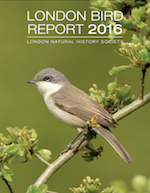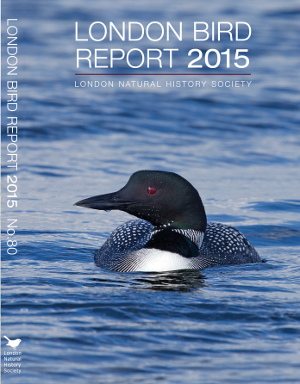Background
The London Bird Report (LBR) has a large section of species accounts which is a digest of key information on around 200 species recorded during the year together with scientific papers. The LBR has a team of over 20 volunteers who compile the species accounts which are at the heart of the LBR. We are looking for up to 20 more writers to join the panel over the coming years to further share the work, significantly reducing the time it takes for each writer and to continue strengthening the panel of writers.
Benefits to Writers
- An opportunity to make a useful contribution that informs science and conservation.
- Be recognised explicitly on the contents listing as a contributing writer. This is useful for people in an early career in research and conservation who want to build out their CVs with citable work.
- Become familiar with handling large volumes of data and learning to extract the highlights. Committee members working in Central London are happy to teach people the necessary skills in Excel from basics of sorting and filtering to more advanced techniques such as how to use pivot tables, and look up functions and sum if functions if you would like to become more conversant with Excel.
- Writing species accounts summaries is a process that leaves you more attuned to digesting information. You also become more cognisant of London’s birding sites and the richness of bird life.
- Be part of a success story. The LBR is a good example of an annually published local ornithological report with records and papers. It has had over 80 issues published since 1936.
What are we looking for?
- You do not need to be an expert, but should be a fairly experienced bird-watcher with knowledge of the current status of birds in London or in the UK; and the sort of person who will enjoy browsing through the LBR.
- You do not need scientific qualifications, but you need to be motivated to self-improve your work skills and be able to understand and follow an established format for presenting information.
- A desire to get something out of it and to grow a little. Also, being prepared to put in the equivalent of at least a solid weekend’s work, and to get it back within six weeks.
What is the process?
- Typically, you will be asked to handle the species accounts for around ten species. The current work load per writer is estimated to take around a whole weekend (less for the more experienced writers). Writers are given six weeks to complete their sections. In the future the amount of work per writer may reduce with more writers being recruited.
- Data is provided for the relevant species in an Excel file. If you are not familiar with Excel, you can ask for training. The final text and tables needed to be provided in MS Word or equivalent software such as Libre.
- Past copies of the LBR are available online. See http://www.lnhs.org.uk/index.php/publications/london-bird-report
- Three examples of species accounts are provided below.
More information
If you would like more information, please contact Editorial Board Secretary, This email address is being protected from spambots. You need JavaScript enabled to view it..
Examples of Species Accounts
Redwing Turdus iliacus
Status: common passage migrant and winter visitor.
Numbers were generally low early in the year, increasing in late February and March, when they presumably included birds on return migration. The last record was of one at Dagenham Chase on the typically late April date of April 26th.
The first returning birds were six at Brook Farm, Upminster, on September 17th. Numbers were higher in this second-winter period than at the start of the year: of the 50 counts of 200 or more, 29 were in the second winter period. Autumn passage was concentrated in early and mid-October, as is usual, peaking on October 9th and October 20th to 21st, with 2,867 noted at 32 sites on the first date. It was not quite as concentrated as in 2015 when all the high counts were in a period of four days. On December 9th, observers at some locations reported a significant movement of birds flying south or south-west. Below are high counts for each sector.
Essex: Orsett Fen, 367 on Dec 26th. Wanstead Flats, 300 over on Oct 20th.
Herts: Ellenbrook Fields, 300 on Dec 11th.
Middx: Hampstead Heath, 1,500 over on Oct 9th. Q. Mary GP, 400 on Mar 19th.
Bucks: Wraysbury GP, 100 on Jan 7th.
Kent: Chislehurst Common, 200 on Dec 20th. Petts Wood, 200 on Dec 19th.
Surrey: Addington Hills, 570 on Dec 16th. Beddington Farmlands, 432 on Oct 20th and 365 on Dec 15th.
In Lond: Primrose Hill, 560 over on Oct 9th. St James’s Park, 400+ over on Dec 9th.
Whinchat Saxicola rubetra
Status: regular passage migrant and former breeding summer visitor.
Spring migrants began arriving from April 12th with one at Upper College Farm. About 96 birds were recorded this spring compared to 160 last year. The peak passage was on April 29th and 30th when 28 birds were seen including a peak of five at Rainham Marshes on the latter date. The last ones of spring were also at Rainham Marshes on May 22nd.
An early autumn migrant was seen at Alexandra Park on July 6th with the only other sighting this month being at London Wetland Centre on 21st. Apart from an isolated fall of ten at Crossness on August 2nd, which was the highest count of the year, only relatively small numbers were seen in August until the last week of the month. This peak period continued through to the first half of September with the peak day being on September 11th when 51 birds were counted. The last of the year was at Walton Res (Knight & Bessborough) on October 13th.
In Lond: Regent’s Park, two on Apr 29th, Aug 23rd and Sep 13th.
Great Tit Parus major
Status: abundant breeding resident.
The number of territories/pairs reported was at least 354 (577 in 2015). Like Blue Tit, it is very under-reported, especially as there were no counts from several sites that had significant numbers breeding in previous years. The Breeding Bird Survey shows no significant change in London since last year, but there was a 9% decrease in England in that period. Below are breeding records for sites where 12 or more were recorded (no. of territories/singing males in brackets), plus a summary of Inner London records and some of the higher counts.
Essex: 80 pairs. Belhus Woods CP (12). Mar Dyke Valley (25). Warren Gorge, 32 on Jan 11th and Dec 15th.
Herts: 80 pairs. Hatfield Park, 38 on Mar 27th. Rickmansworth Aquadrome (12). Rye Meads (52).
Middx: 38 pairs. Fryent CP, 29 on Feb 29th. Home Park (22).
Bucks: Reported from seven sites with a peak of 22 at Wraysbury GP on Apr 5th.
Kent: Six pairs. Darenth Lakes, 25 on Feb 15th.
Surrey: 173 pairs. Ashtead Common (15). Banstead Wood (14). Beddington Farmlands (38). London Wetland Centre (15); 45 on Feb 23rd. Morden Hall Park (12). Surbiton (12).
In Lond: Reported from 39 sites (11 in 2015), but pairs, singing or evidence of breeding was reported at only two sites (down from five in 2015). Battersea (1). Globe Town (1). Hyde Park/Kensington Gdns, 50 on May 29th.
About the London Bird Report
The London Bird Report is an outstanding example of an annual, ornithological publication which has been published since 1937. It is currently a handsome publication of up to 256 pages and counts amongst its editorial team some of the best known names in London and the home counties as well as people who are personalities on the wider British scene. The authoritative publication brings together the efforts of professional ornithologists and casual bird watchers to produce an annual distillation of bird records in the recording area of the London Natural History Society (a 20-mile radius from St Pauls Cathedral).
Many people volunteer to take on a range of tasks from copy editing or the compilation of species accounts to reviewing scientific papers which have been received. The work is overseen by a strong LBR Editorial Board.
 |
 |
 |
